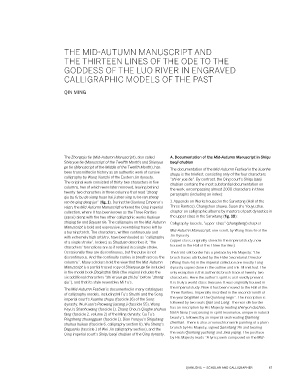Page 69 - Sotheby's Qianlong Calligraphy Oct. 3, 2018
P. 69
THE MID-AUTUMN MANUSCRIPT AND
THE THIRTEEN LINES OF THE ODE TO THE
GODDESS OF THE LUO RIVER IN ENGRAVED
CALLIGRAPHIC MODELS OF THE PAST
QIN MING
The Zhongqiu tie (Mid-Autumn Manuscript), also called A. Documentation of the Mid-Autumn Manuscript in Shiqu
Shieryue tie (Manuscript of the Twelfth Month) and Shieryue baoji chubian
ge tie (Manuscript of the Middle of the Twelfth Month), has The documentation of the Mid-Autumn Festival in the Xuanhe
been transmitted in history as an authentic work of cursive shupu is the briefest, consisting only of the four characters
calligraphy by Wang Xianzhi of the Eastern Jin dynasty. “shi er yue tie”. By contrast, the Qing court’s Shiqu baoji
The original work consisted of thirty-two characters in five chubian contains the most substantial documentation on
columns, two of which were later removed, leaving behind the work, encompassing almost 2000 characters in three
twenty-two characters in three columns that read “zhong paragraphs (including an index):
qiu bu fu bu de xiang huan hai ji shen xing ru he ran sheng
ren he qing deng jun” (fig. 1). During the Qianlong Emperor’s 1. Appendix on Works housed in the Sanxitang (Hall of the
reign, the Mid-Autumn Manuscript entered the Qing imperial Three Rarities), Changchun shuwu, Suian shi, Youyu zhai,
collection, where it has been known as the Three Rarities chapter on calligraphic albums by masters of past dynasties in
(sanxi) along with the two other calligraphic works Kuaixue the upper class in the Sanxitang (fig. 10):
shiqing tie and Boyuan tie. The calligraphy on the Mid-Autumn Calligraphy fascicle, “upper class” (shangdeng) chapter
Manuscript is bold and expressive, resembling traces left by
a burning torch. The characters, written continuously and Mid-Autumn Manuscript, one scroll, by Wang Xianzhi of the
with extremely high artistry, have been lauded as “calligraphy Jin Dynasty
of a single stroke”. Indeed, as Shuduan describes it, “the (upper class, originally stored in the imperial study, now
characters’ formations are as if realised in a single stroke. housed in the Hall of the Three Rarities)
Occasionally they are discontinuous, but the pulse is not The front silk border has a preface by His Majesty: “the
discontinuous. And the continuity carries in breath across the brush traces attributed by the Elder Secretariat Director
columns”. Many scholars hold the view that the Mid-Autumn [Wang Xianzhi] in the imperial collection are mostly Tang-
Manuscript is a partial traced copy of Shieryue ge tie included dynasty copies done in the outline-and-ink-fill method. The
in the model book Baojinzhai fatie (the original includes the only exception is this authentic brush trace of twenty-two
six additional characters “shi er yue ge zhi bu” before “zhong characters. Here the author’s spirit is as if vividly present.
qiu”), and that its style resembles Mi Fu’s. It is truly a world-class treasure. It was originally housed in
The Mid-Autumn Festival is documented in many catalogues the imperial study. Now it has been moved to the Hall of the
of calligraphy models, including Mi Fu’s Shushi and the Song Three Rarities. Imperially inscribed in the second month of
imperial court’s Xuanhe shupu (fascicle 16) of the Song the year bingshen of the Qianlong reign”. The inscription is
dynasty; Wu Kuan’s Paoweng jiacang ji (fascicle 55), Wang followed by two seals Qian and Long. The rear silk border
Keyu’s Shanhuwang (fascicle 1), Zhang Chou’s Qinghe shuhua has an inscription by His Majesty reading shenyun duchao,
fang (fascicle 2, volume 2) of the Ming dynasty; Gu Fu’s tianzi texiu (‘surpassing in spirit resonance, unique in natural
Pingsheng zhuangguan (fascicle 1), Bian Yongyu’s Shigutang beauty’), followed by an imperial seal reading Qianlong
shuhua huikao (fascicle 6, calligraphy section 6), Wu Sheng’s chenhan. There is also a monochrome ink painting of a plum
Daguanlu (fascicle 1 of Wei-Jin calligraphy section), and the branch by His Majesty, signed Sanxitang zhi and bearing
Qing imperial court’s Shiqu baoji chubian of the Qing dynasty. the seals Qianlong yushang and Jixia yiqing. The postface
by His Majesty reads “A lyric poem composed on the Mid-
QIANLONG — SCHOLAR AND CALLIGRAPHER 67

